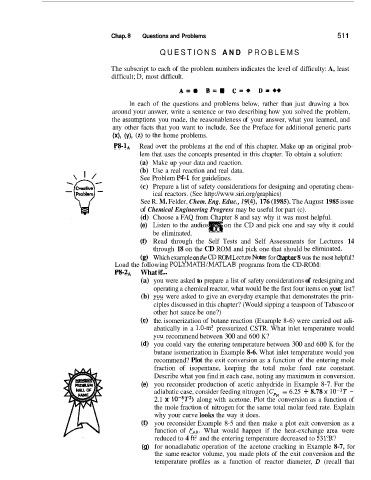Page 541 - Elements of Chemical Reaction Engineering Ebook
P. 541
Chap. 13 Questions and Problems 51 1
QUESTIONS AND PROBLEMS
The subscript to each of the problem numbers indicates the level of difficulty: A, least
difficult; D, most difficult.
A=. B-I C=+ D=++
In each of the questions and problems below, rather than just drawing a box
around your answer, write a sentence or two describing how you solved the problem,
the as:sumptions you made, the reasonableness of your answer, what you learned, and
any other facts that you want to include. See the Preface for additional generic parts
(x), (y), (2) to thie home problems.
P8-lA, Read alver the problems at the end of this chapter. Make up an original prob-
lem that uses the concepts presented in this chapter. To obtain a solution:
(a) Make up your data and reaction.
(b) Use a real reaction and real data.
See Problem P4-1 for guidelines.
(c) Prepare a list of safety considerations for designing and operating chem-
ical reactors. (See http://www.siri.org/graphics)
See R. M. Felder, Chem. Eng. Educ., 19(4), 176 (1985). The August 1985 issue
of Chemical Engineering Progress may be useful for part (c).
(d) Choose a FAQ from Chapter 8 and say why it was most helpful.
(e) Listen to the audios on the CD and pick one and say why it. could
be eliminated.
(f) Read through the Self Tests and Self Assessments for Lectures 14
through 18 on the CD ROM and pick one that should be eliminated.
(g) Which example on the CD ROM Lecture Now for Chapter 8 was the most helpful?
Load the following POLYMATH/MATLAB programs from the CD-ROM:
PS-2A, What if...
(a) you were asked to prepare a list of safety considerations of redesigning and
operating a chemical reactor, what would be the first four items on yaw list?
(b) you were asked to give an everyday example that demonstrates the prin-
ciples discussed in this chapter? (Would sipping a teaspoon of Tabasco or
other hot sauce be one?)
(c) the. isomerization of butane reaction (Example 8-6) were carried out adi-
abatically in a 1.0-m3 pressurized CSTR. What inlet temperature would
you recommend between 300 and 600 K?
(d) you could vary the entering temperature between 300 and 600 K for the
butane isomerization in Example 8-6. What inlet temperature would you
recommend? Plot the exit conversion as a function of the entering mole
fraction of isopentane, keeping the total molar feed rate constant.
Describe what you find in each case, noting any maximum in conversion.
(e) you reconsider production of acetic anhydride in Example 8-7. For the
adiabatic case, consider feeding nitrogen (Cp, = 6.25 + 8.78 x 10-3T -
2.1 x 10-8T2) along with acetone. Plot the conversion as a function of
the mole fraction of nitrogen for the same total molar feed rate. Explain
why your curve looks the way it does.
(f) you reconsider Example 8-5 and then make a plot exit conversion as a
function of FAo. What would happen if the heat-exchange area were
reduced to 4 ft2 and the entering temperature decreased to 531"R?
(g) for nonadiabatic operation of the acetone cracking in Example 8-7, for
the same reactor volume, you made plots of the exit conversion and the
temperature profiles as a function of reactor diameter, D (recall that

